|
Wayfarers
All the Way Down
...Chip Cunningham, Solje W1321 |
|
Esteemed
Professor: Many Native American cosmologies place the Earth
on
the back of a giant turtle.
Curious Student: Well, what’s the turtle standing on? Professor: Another turtle. Student: So, what’s that turtle standing on? Professor: Another turtle. Student: How many turtles are there? Professor: Nobody knows for sure; but it’s turtles all the way down.
Traditional
At the beginning of
this year, 2012, I was trying hard to make a big
mistake. Sky, my wife and so-far mostly phantom crew on Solje
W1321, had said toward the end 2011’s sailing season, “If we go out
cruising, I don’t want to sit for days in the rain. I want something
with a cabin."
 So I began torturing
myself with the notion of finding a sailboat with
a small cabin that was (in order of importance) beautiful, seaworthy,
trailerable and affordable. You may already see the flaw. I hope
you never find out how easy it is to become obsessed with the hull
designs, capsize ratios, and the sheer beauty of the hundreds of small
yachts that you can find any minute any day (or night) on your
computer. The ones that sold quickly—perfect solutions lost
forever.
There must be an aphorism about the most beckoning being the farthest away. Chester, Nova Scotia, is 27 hours from my home in Michigan. To tow back home the “Bristol Condition Alberg 22 and trailer” I had found, I traded my economical but insufficiently powerful Toyota pickup for an insufficiently economical but powerful Chevrolet pickup. In Nova Scotia I was met by the alcoholic broker and the uncurious surveyor that I had engaged to preview the boat. Let me just say that the boat might have been Bristol ten years ago. The trailer had never been. I drove back home depressed but relieved that I wasn’t towing that boat behind me. I know what would have happened: the boat lying on its side across both lanes of construction detour in downtown Montreal. Chastened, I resolved not to stray farther than 12 hours from home. It was no problem finding boats that far away to look at. To Milwaukee, for instance, or to New Liskeard, 100 miles north of North Bay, where a moose chased me off the road. Somewhere in all this I
met a man who has forty boats all 26’ LOA or
less. There is something compelling about a man with forty
boats. He gave me one good piece of advice, “moisture meter,” and
exponentially increased the difficulty of finding a boat in suitable
condition. Early fiberglass layups involved two layers of fiberglass
with varying core materials, like balsa, or pressed-board, or
foam. Fiberglass being a new technology, it was insufficiently
understood
that it is permeable to some extent, and that any holes through
it also allow water into the core where it reacts with the core
materials and becomes acidic and—but that’s another story.
It’s enough to know that you don’t want to buy a boat with a wet core. While finding the wet core may not be easy, finding a boat with one is. Even so, I finally did find the boat of my dreams, a Cape Dory 22, which is an updated Alberg 22. She was in Sackets Harbor on Lake Ontario. My forty-boat friend even guessed the boat and her owner and recommended them both. Many long emails and lots of pictures later, I had a strong feeling she was the one. Good sails. No inboard motor. Not a lot of fancy electronics. Dry. A top notch trailer. And a very likeable owner. I add this last observation because it was one of the best things to come with Solje. 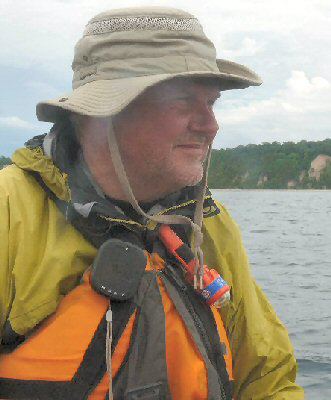 Solje's previous owner, Gary Hirsch Ah, Solje!
Back to Solje. I had just spent three weeks
giving her a new aluminum powder/epoxy bottom and varnish over a clear
epoxy sealer on her decks. Robert Mosher and I made plans to take
her to the regattas in North Bay for her coming out. She looked
beautiful. I would go see the Cape Dory 22 the following weekend.
The Wayfarer National Long Distance Race was wonderful. We would
have finished under the time limit had the jib tensioner not blown to
pieces. The flogging genoa undid its tack and was streaming like
a pennant from its head. I really love passage races.
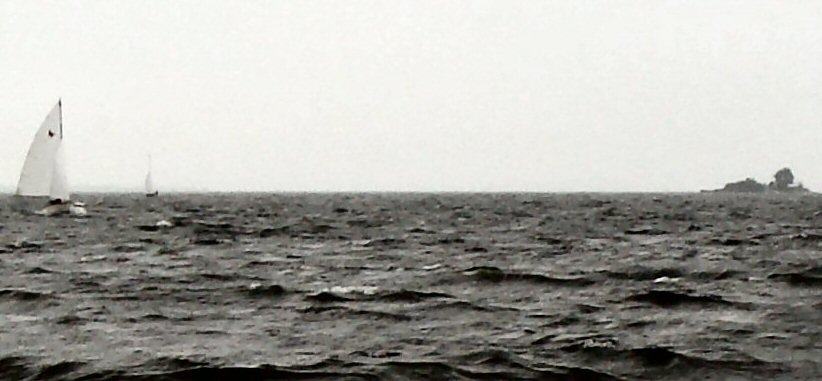 Solje during and ... 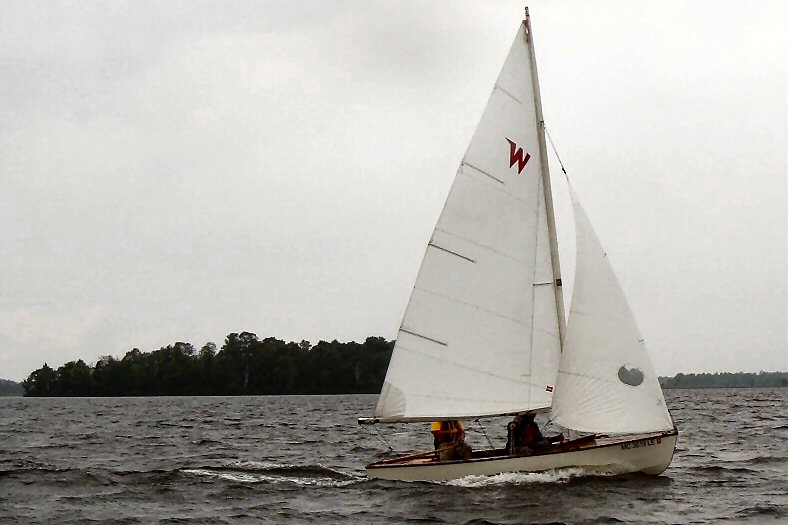 ... after the squall Passing Uncle Al only to find the race was already over. The Canada Day Race, Robert and I got into some trouble (but got back out before the weekend was over.) At the buoy south of North Bay where we were to turn east into the channel for Callander Bay. we were hit from port aft by what seemed like a full gale to me, but what Uncle Al’s perspective downgraded to a brief squall (pics above). Everyone else struck their sails. I thought if we could just keep the boat upright, it was a perfect opportunity to blast into first place. And except for Hansman’s Beowulf it looked like we would have. Alas, we didn’t understand that the race had been shortened to the turning buoy. I wonder if either Robert or I will ever go that fast in a Wayfarer again. Monday I crewed for Al
in the Don Rumble Memorial Series, a nearly
overwhelming introduction to the finer points of Wayfarer sailing. By
Monday evening I was thoroughly exhausted. I went out in a dying
breeze and dozed off sailing Solje back and forth
on beautiful Callander Bay. Sailing with Al had given me one glimpse
into how far I had to go. Another stunning indication happened at
Clark Lake in 2011, my first race as helm. It was a
windward-leeward course, two times around. As I was rounding the
leeward mark for the first time, the Heffernans and Al were flying
across the line for a close finish, and hence sailing twice as fast as
I was. Twice is quite a bit.
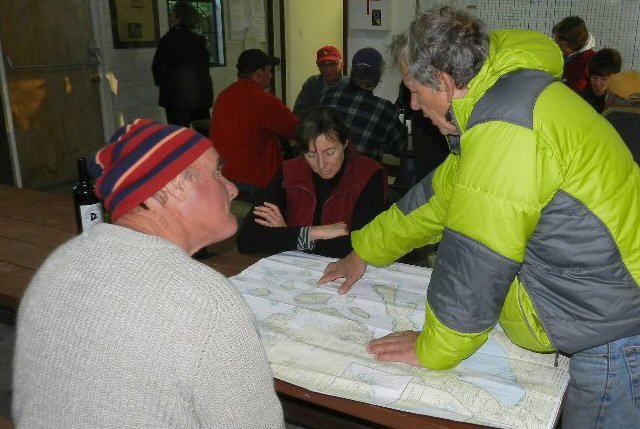 Robert Mosher (r) and Chip talk cruising at the Pumpkin. So, on the drive home
from North Bay it finally hit me, “What was I
thinking? Another boat!” That was the same question Robert
had posed to Sky and me when we told him of our bigger-boat plans on
the ride back from the Canadian Wayfarer Association’s 2012 Annual
General Meeting. So it wasn’t really news to him when I announced
that
I was not interested in the Cape Dory 22 after all: two boats and
I’d probably never learn to sail or take care of either of them well.
What a joy is an undivided heart. When I sail, it’s Solje. I can be on the water of a large and uncrowded lake in little over a half-hour. This is probably a good place to mention another major feature of my life: Sky’s garden. It is unquestionably hers. I am allowed to supply what has traditionally been done by mules. We grow most of what we eat, so the garden comes first. By that I mean that during the height of the planting season you might as well not even ask Sky to pass the salt. Any chance that she might go sailing has to wait until at least mid-July. My garden indenture, however, allows me to sail maybe four afternoons a week. Our first attempt at
sailing together was at Fanshawe’s
sufficiently-late-in-the-season Pumpkin Regatta in 2011. We were
mercifully cautioned by almost all the other competitors to not begin
our racing career in such high and fluky winds. No kidding: that
race would have certainly been the last time Sky and I were ever in a
boat together. Even Sue Pilling and Steph Romaniuk capsized
before the start of the first race — twice!
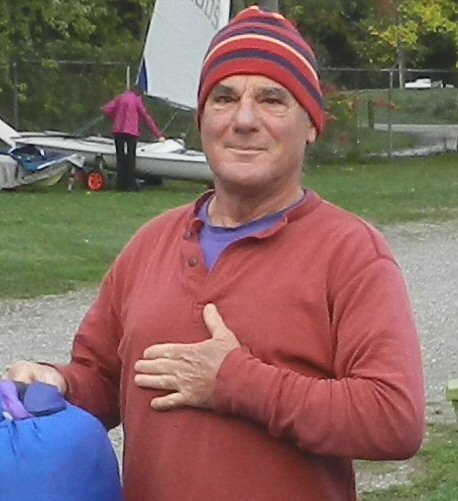 Chip at the 2012 Pumpkin at Fanshawe Lake - ready to take on the Trent-Severn But we had a great time and we got to meet Vera and Jeff Eames who told us about their recent cruise down the Rideau Canal which they described as their best ever. Their main advice was to “wait until all the kids go back to school.” That fit with the garden, so Sky and I immediately set it as a goal for 2012. We began researching the Rideau, but soon got interested in another canal we were aware of only by name: the Trent-Severn. The Trent-Severn Waterway runs generally westward from Trenton, Ontario, on the Bay of Quinte in northeast Lake Ontario through a series of rivers, lakes and canals across lower Ontario to Port Severn at the southeast end of the Georgian Bay. As the crow flies it is
120 miles, by the waterway 240 miles, through
45 locks, past 36 swing bridges and under 24 stationary bridges with a
minimum clearance of 22 feet. Now, a Wayfarer can be heeled to make it
under
twenty-two feet but having already read about “shooting a bridge”, what
better reason to learn? So this year at our first opportunity in
late July, Sky and I headed for the public launch on the Black River in
Port
Huron. There are four bridges in the mile between the launch and
the St. Clair River, the highest being 18’ and the lowest six
feet.
The wind was against
us, so we motored out. Motoring allowed us to
concentrate on the mechanics of dropping the mast. Solje came
with one pair of blocks in her forestay. The line
through them leads through the splash board to a cleat in the
cockpit. It is a simple matter for one person to raise and lower
the mast. The process is:
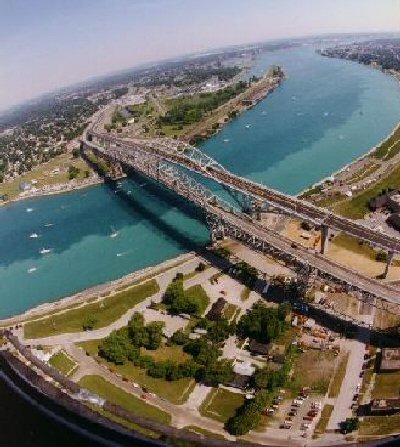 The Blue Water Bridges: Lake Huron would be just off to the left. We motored on out into the St Clair River and up the US side —the outside of the bend— against a 5 knot current with standing waves and huge ominous smooth upwellings. The river is forty feet deep along there and about a thousand feet wide. That’s a lot of water and it feels like it! Under the two Blue Water Bridges—it’s quite something, all that structure 135’ overhead—and then suddenly you’re in Lake Huron. It’s big. It was also warm and clear with a 10-knot wind. We were relieved to
shut the motor off and set sail. Three
hundred feet from shore we could jump out of the boat into waistdeep
water onto a white sand bottom. We took turns towing each other
behind the boat. Then we sailed around the channel buoys, across
the
shipping lane and into Canadian water. We sailed on a run back into the
St Clair River, swept along with enough steerage way to keep off the
breakwall. We were passed by a lake freighter and one salty
heading upriver. They made far less wake than the occasional
monster speedboat.
We turned into the Black River on a reach. At the first bridge I dropped the mast all the way and Sky helmed the shot. At the next bridge, I lowered the mast just enough to clear. The jib which we hadn’t dropped all the way was still catching air and pulled us neatly under the bridge. We were applauded for that bit of good luck by some people on an outdoor restaurant deck. On to the Trent-Severn!
Except that Sky spent September flirting with
whooping cough. Our plan to sail in the Pumpkin and go from there
on to Orillia to sail the Trent-Severn to Port Severn and back took on
a singlehanded aspect. I got an invitation from Al to crew for
him at the Pumpkin and I accepted. When I first started sailing Solje
I had a nebulous concern about capsizing. Now that I
have capsized I have a focused concern about losing stuff if I
do. A ten-day cruise is a lot of stuff.
I outfitted Solje with
six 16”x 24” lidded plastic tubs.
They weren’t waterproof, but they weren’t going to fall out. They were
each lashed down with two lines through holes in the floorboards.
The two 16” high ones went on each side up against the forward bulkhead
under the deck. They held a land tent, sleeping gear and clothes
that I wouldn’t need to access more than once a day. The two 12”
high tubs fit lengthwise across in front of the rear bulkhead.
One held cooking gear. The other held a selection of outerwear, hats
and gloves. The two 9” high ones fit athwart under the
thwart. One held food and the other held charts, a VHF radio, and
small stuff like that. They untied easily and stacked out of the
way at night. I wouldn’t change a thing for the next trip. Boom tent in
the rear compartment. A working jib and a
spare main in the forward.
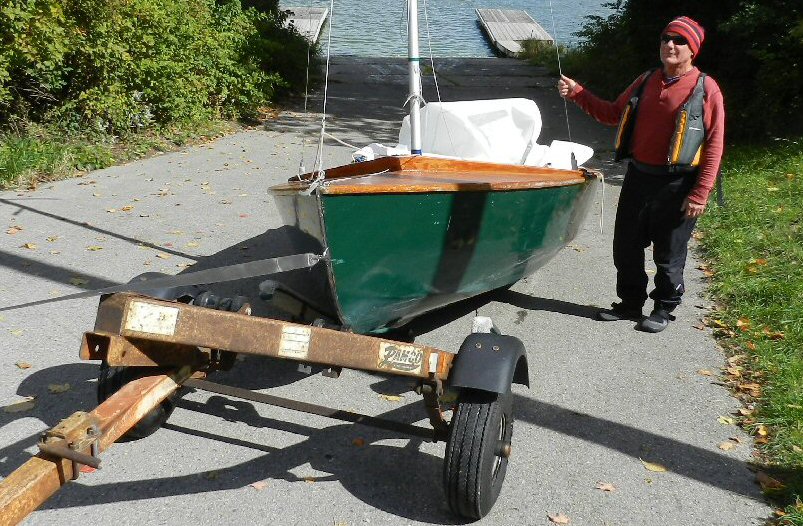 I stopped in Fanshawe
long enough to pick up first place with Al in the
lightly attended Pumpkin regatta. Then, hauling Shades out,
Al and I stopped on the ramp long enough (photo above) to pick
up this year’s
Lansdown Spittoon. I got to the Orillia municipal ramp at sundown
Sunday, rigged Solje under a streetlight, launched her,
got the boom tent up and went to sleep.
In the morning the ramp
was busy with barges, construction crews and
big equipment. I cooked a pressure cooker full of beans and
potatoes and headed north into Lake Couchiching. I sailed with a kind
of worried intensity. It was about as windy as I would want it on
such a shallow lake. I furled the genoa a couple of times.
Then sailing past some tree-covered rocks about three quarters of the
way up the lake it hit me—I don’t have to be anywhere for the next ten
days. So I sailed into the lee of the rocky island and made a cup
of tea. It just got better and better from then on. Around each
turn I would see a maple tree that was redder than the last. One
day I only saw ten other boats. At night I would sail into the
most beautiful place I could find, drop the anchor and go to sleep. I’d
love a race down the Trent-Severn—like a Tour de Ontario in
Wayfarers. I have one word for you though: take a working jib.
... |